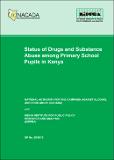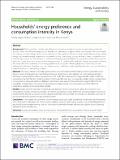Discussion Paper No. 164 of 2014 on Alcohol Consumption and Healthcare Expenditure in Kenya
Publication Date
2014Author
Type
Discussion Paperviews
downloads
Metadata
Show full item recordBy
Kanina, Jane W.
Abstract/
This study investigates the factors influencing alcohol consumption and the effects of alcohol consumption on healthcare expenditure in Kenya using data from the 2005 Kenya Integrated Household Budget Survey (KIHBS). The analysis made use of the Cragg’s double hurdle model, also known as two-part model when applied to cross-sectional data. The model splits the households’ decision into two: the participation and the consumption decision. Participation decision is examined in the context of a logistic model, while the consumption decision given the decision to consume is analyzed with a log-linear regression. Descriptive results show that there are differences in alcohol consumption across different regions in Kenya, in terms of the number of households and the total expenditure on alcohol. Estimation results show that the participation and consumption decisions are significantly influenced by social, economic and demographic characteristics. In particular, presence of children, household head being female, and head being married reduces the likelihood of alcohol participation, while increase in age of the household head, tobacco consumption and increase in income increases the likelihood to drink alcohol. However, the increase in age has an inverted u-shape with a point where further increase in age reduces the probability of participation. On the other hand, female headed households, presence of children aged 0-14 years, and increase in household size by a member reduces alcohol expenditure by 30, 20 and 5 per cent, respectively. Households using tobacco spend 15 per cent more on alcohol while an increase in income by 1 per cent increases expenditure on alcohol by 0.73 per cent. Effects of alcohol consumption on healthcare expenditure was indeterminate, since it had different signs in the participation and the consumption decision.
Subject/
Alcohol Consumption; Healthcare Expenditure; Tobacco consumption; Alcoholic Drinks; Kenya
Publisher
The Kenya Institute for Public Policy Research and Analysis (KIPPRA)Series
DP/164/2014Collections
- Discussion Papers [348]
Related items
Showing items related by title, author, creator and subject.
-
Kakamega County Policy for Prevention and management of Alcohol and Drug Abuse at the work Place
County Government of Kakamega (County Government of Kakamega, 2022)The National ADA Policy identifies ADA as a major problem affecting not only the socio economic development but also the physical, emotional and social wellbeing of the citizens in the entire Republic of Kenya. ADA is a ... -
Special Paper No. 20 of 2019 on Status of Drugs and Substance Abuse among Primary School Pupils in Kenya
The Kenya Institute for Public Policy Research and Analysis (KIPPRA) (The Kenya Institute for Public Policy Research and Analysis (KIPPRA), 2019)Introduction Studies in Kenya indicate that drugs and substance abuse among young people in learning institutions is a growing social and public health problem. Most of these studies have, however, focused on young persons ... -
Households' Energy Preference and Consumption Intensity in Kenya
Kisaka, Oscar Masika; Gikonyo, Joseph & Mbaka, Charity Kageni (BioMed Central Ltd, 2019)There have been notable joint efforts from the private and public sectors in promoting households’ access to clean and efficient energy sources. Despite the noteworthy progress realized over the years, the consumption and ...




